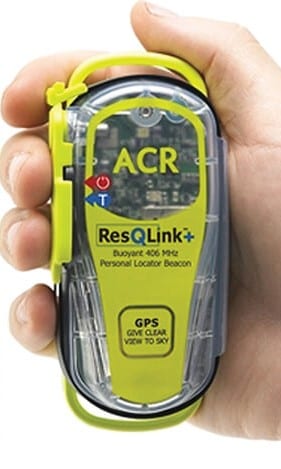Sheri Daye
After several years of traveling for work, I had enough frequent flyer miles to take my family to Australia to dive on the Great Barrier Reef. After returning home, we heard on the news that two Americans had accidentally been left at sea by the same dive operator we had chartered. The crew miscounted when tracking divers, and by the time the search began, they most likely suffered a slow, agonizing death.
That nightmare incident was portrayed in a Hollywood movie. Unfortunately, these “left-at-sea” stories are not uncommon. Boats can become incapacitated; divers can get caught in a current; the possibilities are endless.
According to U.S. Coast Guard rescue swimmers, the key to getting rescued is to make yourself visible. A whistle or Dive Alert air horn might be enough to catch the attention of your boat if it is nearby. If lost, it helps if you are wearing a brightly colored wetsuit hood or deploy a brightly colored safety sausage. Even better, you can carry signaling devices such as flares, a mirror (requires the sun), or glow sticks (at night). A small LED dive flashlight or strobe can be seen from afar—especially if the USCG is searching with night vision goggles.
PLBs (Personal Locator Beacons) on the market today are small, waterproof devices designed to alert search and rescue services of your location anywhere in the world. When activated, it transmits a message on the 406 MHz distress frequency which is monitored by the COSPAS-SARSAT satellite system. The alert is relayed to the nearest Rescue Coordination Center. Once in the area, rescue services pinpoint your location using 121.5 MHz homing transmitters. Unlike EPIRBs, which are registered to a specific vessel, a PLB is registered to a person and can be carried wherever you go.
Before my trip, I bought an ACR ResQLink PLB from Bass Pro for $249. It can be used on land or sea, but divers need to know that taking it deeper than 5 meters could cause the device to activate due to pressure changes, so it should either be secured to a flag float on the surface or stored in a dive canister if taken underwater. The increased peace of mind was well worth the price.
There are several similar products on the market. The Ocean Signal rescueME PLB1 operates in a similar manner. Nautilus Lifeline makes a “Marine Rescue GPS” which broadcasts a distress message to all AIS equipped ships up to 34 miles away and to the marine radio on your own vessel.
The ultimate survival tool is your ability to keep calm and maintain a positive attitude while taking action to make yourself visible. Prepare ahead of time, and your chances of rescue are very good. Safe diving!
Sheri Daye is a world-record holder, host of Speargun Hunter, and producer of “The Blue Wild Ocean Adventure Expo” in Fort Lauderdale, Fla. Follow “Sheri Daye” and “The Blue Wild” on Facebook and Instagram.
